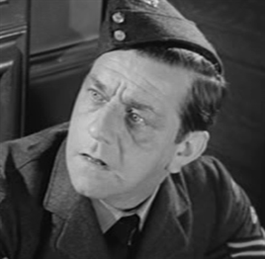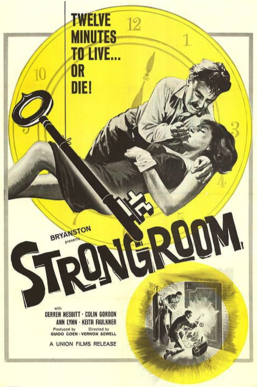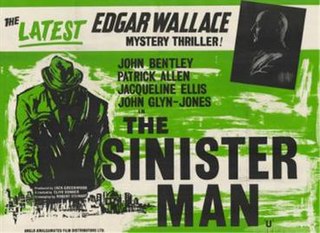
Room at the Top is a 1959 British drama film based on the 1957 novel by John Braine. It was adapted by Neil Paterson, directed by Jack Clayton, and produced by John and James Woolf. The film stars Laurence Harvey, Simone Signoret, Heather Sears, Donald Wolfit, Donald Houston, and Hermione Baddeley.
Derren Nesbitt is a British actor. Nesbitt's film career began in the late 1950s, and he appeared in many British television series throughout the 1960s and 1970s. He is perhaps best known for his role as Major von Hapen in the 1968 film Where Eagles Dare.

Robbery is a 1967 British crime film directed by Peter Yates and starring Stanley Baker, Joanna Pettet and James Booth. The story is a heavily fictionalised version of the 1963 Great Train Robbery. The film was produced by Stanley Baker and Michael Deeley, for Baker's company Oakhurst Productions.

The Blood Beast Terror is a 1968 British horror film directed by Vernon Sewell and starring Peter Cushing, Robert Flemyng and Wanda Ventham. It was written by Peter Bryan. It was released in the UK by Tigon in February 1968, and in the United States by Pacemaker Pictures on a double-bill with Slaughter of the Vampires (1962).

Hell Is a City is a 1960 British crime thriller film directed by Val Guest and starring Stanley Baker, John Crawford and Donald Pleasence. It was written by Guest based on the 1954 novel of the same title by Maurice Procter, and made by British studio Hammer Film Productions on location in Manchester. It was partly inspired by the British New Wave films and resembles American film noir.

Sword of Sherwood Forest is a 1960 British Eastman Color adventure film in MegaScope directed by Terence Fisher and starring Richard Greene, Peter Cushing, Niall MacGinnis and Sarah Branch. Greene reprises the role of Robin Hood, which he played in The Adventures of Robin Hood TV series 1955–1959. It was produced by Sidney Cole and Greene for Hammer Film Productions.

Harry Locke was an English character actor.

Ooh... You Are Awful is a 1972 British comedy film directed by Cliff Owen and starring Dick Emery, Derren Nesbitt, Ronald Fraser and Cheryl Kennedy. It was written by John Warren and John Singer. It is a feature-length adaptation of The Dick Emery Show. It was Emery's sole starring film.

The Informers is a 1963 British crime film directed by Ken Annakin and starring Nigel Patrick, Margaret Whiting, Harry Andrews, Derren Nesbitt and Colin Blakely. It was produced by William MacQuitty, with screenplay by Paul Durst and Alun Falconer from the novel Death of a Snout by Douglas Warner. Cinematography was by Reginald H. Wyer. It was distributed in the UK by The Rank Organisation and the U.S. by Continental Film Distributors.

Strongroom is a 1962 British 'B' crime drama film directed by Vernon Sewell and starring Derren Nesbitt, Colin Gordon and Ann Lynn. A group of criminals lock two bank employees in a safe during a robbery.
Strange Evidence is a 1933 British crime film directed by Robert Milton, produced by Alexander Korda and written by Lajos Bíró and Miles Malleson. Starring Leslie Banks, George Curzon, Carol Goodner and Frank Vosper, it is a film made by Alexander Korda's London Film Productions at British and Dominions Imperial Studios, Elstree, with art direction by R.Holmes Paul.

Burke & Hare is a 1972 horror film directed by Vernon Sewell and starring Derren Nesbitt, Harry Andrews, and Glynn Edwards. It is based on the true story of the Burke and Hare murders, and was the last film to be directed by Sewell.

Dancing with Crime is a 1947 British film noir film directed by John Paddy Carstairs, starring Richard Attenborough, Barry K. Barnes and Sheila Sim. A man hunts down the killer of his lifelong friend.
Funny Money is a 1983 British crime film directed by James Kenelm Clarke and starring Gregg Henry, Elizabeth Daily and Derren Nesbitt. The Film was distributed by Cannon Films. The film's sets were designed by the art director Harry Pottle.

A Matter of Choice is a 1963 British black and white drama film directed by Vernon Sewell and starring Malcolm Gerard, Michael Davis, Anthony Steel, Jeanne Moody and Ballard Berkeley. The screenplay was by Paul Ryder based on an original story by Sewell and Derren Nesbitt.

A Man on the Beach is a 1955 British fiction colour featurette directed by Joseph Losey and starring Donald Wolfit, Michael Medwin and Michael Ripper. It was produced by Anthony Hinds for Hammer Films and written by Jimmy Sangster adapted from the story "Chance At the Wheel" by Victor Canning.

The Sinister Man is a 1961 British crime drama film directed by Clive Donner and starring Patrick Allen and John Bentley. It was one of the series of Edgar Wallace Mysteries, British second-features, produced at Merton Park Studios in the 1960s.

Never Back Losers is a 1961 British 'B' crime film directed by Robert Tronson and starring Jack Hedley, Jacqueline Ellis and Patrick Magee. It was written by Lucas Heller based on the 1929 novel The Green Ribbon by Edgar Wallace. It was one of the Edgar Wallace Mysteries series, produced at Merton Park Studios in the early 1960s.
Escape Route is a 1952 British black-and-white second feature thriller film, directed by Seymour Friedman and Peter Graham Scott, and starring George Raft, Sally Gray and Clifford Evans.

Dangerous Voyage is a 1954 British crime thriller B film directed by Vernon Sewell and starring William Lundigan, Naomi Chance and Vincent Ball. It was written by Sewell and Julian Ward and was distributed by Anglo-Amalgamated in the UK, and in the United States by Lippert Pictures.
















